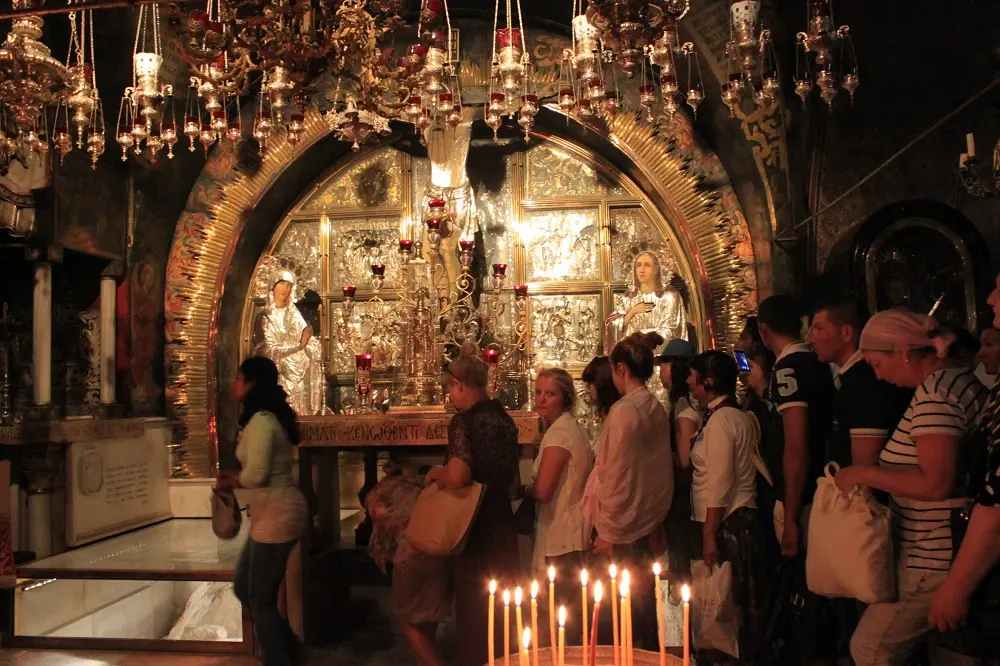The path in Old Jerusalem that Jesus took bearing his cross
Easter is a time when one remembers the suffering of Jesus Christ as he was condemned and then crucified before his soul rose to Heaven. Retracing the final mortal journey of Jesus through what is today Old City of Jerusalem, Asha Ramachandran reminisces a walk down the pathway that is marked by 14 incidents
We have all of us grown up with the Biblical narrative of the life of Jesus Christ and his final moments before he was crucified. But to step on to the path that Jesus is said to have taken, bearing on his back a heavy wooden cross, is a humbling experience. Walking up the flagstone paved pathway is difficult enough and the final climb to the place of crucifixion leaves one benumbed at the thought of what a frail, injured Jesus must have gone through. The Via Dolorosa, or Way of the Cross, is a mile-long route through the Old City of Jerusalem, in Israel, leading from the Antonia Fortress, where Jesus was condemned by Pontius Pilate, to Golgotha (Calvary), the place of the crucifixion. The route, through which Jesus is believed by the faithful to have walked, carrying his heavy cross, is today a venerated place for Christian pilgrims from around the world. Whereas the names of several roads in Jerusalem are translated into English, Hebrew, and Arabic for their signs, the name Via Dolorosa is used in all three languages.
Also read: Wieliczka Salt Mines: A love story and an ode to survival (travellernook.com)
The Stations
The Via Dolorosa is marked by 14 Stations, each a point on the route depicting an incident in Jesus’ final mortal journey. At each Station there is now a chapel or marker. The traditional site of Golgotha-Calvary, where Jesus was crucified, is the Church of the Holy Sepulcher though some Christian denominations consider the Garden Tomb, outside the current Old City walls, to be the true site of Golgotha-Calvary. The last five stations are located within the Church of the Holy Sepulchre.
The 14 Stations are listed thus:
Station I ~ Antonia Fortress; Pilate condemns Jesus
Station II ~ The Chapel of the Condemnation (Lithostratos): Jesus takes up the cross
Station III ~ Jesus falls under the cross for the first time
Station IV ~ Jesus meets his mother
Station V ~ Simon of Cyrene helps Jesus carry the cross
Station VI ~ A Jerusalem woman wipes Jesus’ face and the cloth takes up the image of
Jesus’ face.
Station VII ~ Jesus falls for the second time
Station VIII ~ Jesus consoles the women of Jerusalem
Station IX ~ Jesus falls for the third time
Station X ~ Jesus is stripped of his garments
Station XI ~ Jesus is nailed to the cross
Station XII ~ Jesus expires on the cross
Station XIII ~ Jesus’ body is taken from the cross and washed (the Stone of Unction)
Station XIV ~ Jesus’ body is laid in the Tomb of Joseph of Aramathea
Also read: Qatar: A pearl in the ocean (travellernook.com)
Incidents and encounters
At the site of the first and second Stations are three early 19th-centuryRoman Catholic churches, taking their names from these events ~ Church of the Condemnation and Imposition of the Cross, Church of the Flagellation, and Church of Ecce Homo. A large area of Roman paving, beneath these structures, was traditionally regarded as the pavement described by the Bible as the location of Pilate's judgement of Jesus. According to popular tradition, Jesus stumbled thrice, marked by Stations 3, 7 and 9. Four stations commemorate encounters between Jesus and other people in the city streets. The New Testament makes no mention of a meeting between Jesus and his mother, marked by the fourth Station, but popular tradition introduces this. At the fifth Station, Simon of Cyrene takes Jesus’ cross and carries it for him. At this station, an imprint of a hand on the stone wall is believed to be that of Jesus as he rested against the stones. A Jerusalem woman wiped Jesus’ face outside her house, at the sixth Station and the cloth is believed to have got supernaturally imprinted with Jesus’ image. “Vera Nika” in Greek means “true image” and thus the woman became known as Veronica.
Also read: Sri Lanka: once a tourist haven now in crisis (travellernook.com)
Golgotha
The stone on which Jesus was crucified is located within the Church of the Holy Sepulchre and reached by climbing a flight of steep steps. It is today enclosed in a glass case with a small hole to allow the faithful to reach in and touch it. Moving down, one can see the Stone of Unction, where Jesus’ body was laid out and prepared for burial. The tomb itself is enclosed in a chamber lit up with lamps and candles lit by the faithful. A peaceful silence surrounds each devotee as one wends through thronging crowds to the sunlight outside.
Also read: The other side of Krakow (travellernook.com)
.png)
